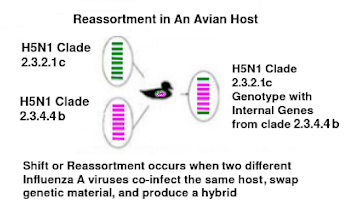
#18,366
While we may be somewhat comforted by the fact that of the 34+ H5N1 cases reported in the United States in 2024 have all been mild, in many other parts of the world different incarnations of the HPAI H5 virus have not been so benign.
In Cambodia, we've seen 18 human H5N1 infections (clade 2.3.2.1c) reported since early 2023, with nearly a 40% fatality rate. And as we've seen previously with other incarnations of HPAI H5N1, Children and adolescents have been the hardest hit.
The FAO wrote:
In Asia, several clades continue to circulate, including A(H5N1) 2.3.4.4b, 2.3.2.1c and others, which can lead to reassortment and the appearance of viruses with new characteristics. A novel reassortant influenza A(H5N1) virus has been detected across the Greater Mekong Subregion (GMS), causing infections in both humans and poultry since mid- 2022.
This virus has recently caused human outbreaks in Cambodia early this year. This virus contains the surface proteins from clade 2.3.2.1c that has circulated locally, but internal genes from a more recent clade 2.3.4.4b virus.
The introduction and widespread circulation of this reassortant influenza A(H5N1) virus into the GMS poses a significant risk to both animal and human health, given the historical impact of HPAI outbreaks in the region. Further, this reassortment event indicates not only the adaptive capacity of the virus but also the ever-present risk of the emergence of new, potentially more virulent strains.Meanwhile, in China, we've been watching the spread and evolution of H5N6 since the spring of 2014, and among the 92 reported cases out of China (likely an undercount), its fatality rate has been running in excess of 50%.
The concern is that - like with the recent changes we've seen in Cambodia's H5N1 virus - the H5N6 virus may be evolving towards becoming a more mobile threat. All of which brings us to a new report out of China of the the detection of H5N6 in wild birds, and signs of continued reassortment with other viruses.Unlike both clade 2.3.2.1c in Cambodia, and the highly prolific clade 2.3.4.4b which has swept the world since 2020, this H5N6 virus has only rarely been detected in wild and migratory birds. With the exception of a single human infection in Laos in 2021, and a few detections in poultry in Vietnam, it has been primarily a threat to China.
The Novel 2.3.4.4b H5N6 Highly Pathogenic Avian Influenza Viruses Isolated From Wild Birds in 2023 Posing a Potential Risk to Human Health
Yuting Xu, Jie Hu, Chenyao Zhao, Yue Yuan, Zijing Gao, Zhenghuan Wang, Kirill Sharshov, Guimei He
First published: 22 October 2024
https://doi.org/10.1155/2024/4900097
Academic Editor: Makoto Ozawa
Abstract
The highly pathogenic avian influenza 2.3.4.4b H5 viruses have been a cause for concern recently, as they have been responsible for continuous outbreaks since 2021. In China, the H5N6 subtype has been predominantly circulating in domestic poultry but has rarely been detected in wild birds over the past 3 years.In December 2023, novel reassortant 2.3.4.4b H5N6 viruses were resurgent in wild birds and domestic ducks in Eastern Asia. The viruses were reassorted with those of currently prevalent 2.3.4.4b H5N1 viruses of wild bird origin worldwide, as well as the H5N6 viruses that caused human infections in 2022 and low pathogenic avian influenza viruses, such as the H9N2 virus, which also contributed internal gene to the novel H5N6 viruses.
Based on the phylogenetic analyses, we inferred that this recombination process occurred in migratory breeding sites in early 2023. Given the rapid transmission and high mutation capacity of currently circulating H5N1 viruses, as well as the strong pathogenicity of H5N6 viruses to humans, the novel recombinant viruses may continue to evolve and pose new threats to human health. Therefore, continuous surveillance of H5N6 viruses in wild birds and domestic poultry should be strengthened.
(SNIP)
In this study, we identified a novel influenza A (H5N6) virus in wild waterfowl in Shanghai in 2023. These findings provide evidence of H5N6 virus recombination, highlighting the role of wild waterfowl for virus cross-region and cross-species transmission. We also demonstrated that this recombinant H5N6 virus may acquire the escalated transmission of 2.3.4.4b H5N1 viruses and the high pathogenicity of H5N6 viruses in domestic poultry and humans, pausing great threats to the poultry industry and human health. Thus, we called for continued attention and monitoring of this novel H5N6 virus worldwide.
We've been extraordinarily lucky that the H5N6 virus hasn't demonstrated the same ability to hitch transoceanic rides on migratory birds the way that clade 2.3.4.4b H5N1 viruses have.
But now that we are seeing reassortments between the deadlier H5N6 virus and the more mobile H5N1 virus, the concern is our luck could change. Earlier this year the FAO warned that reassortments between H5N1 clade 2.3.2.1c and 2.3.4.4b in Cambodia pose similar risks.
While we are understandably focused on HPAI H5 in our own backyard, the world is a very big place - and if a pandemic virus emerges anywhere - it will very quickly become a problem everywhere.

